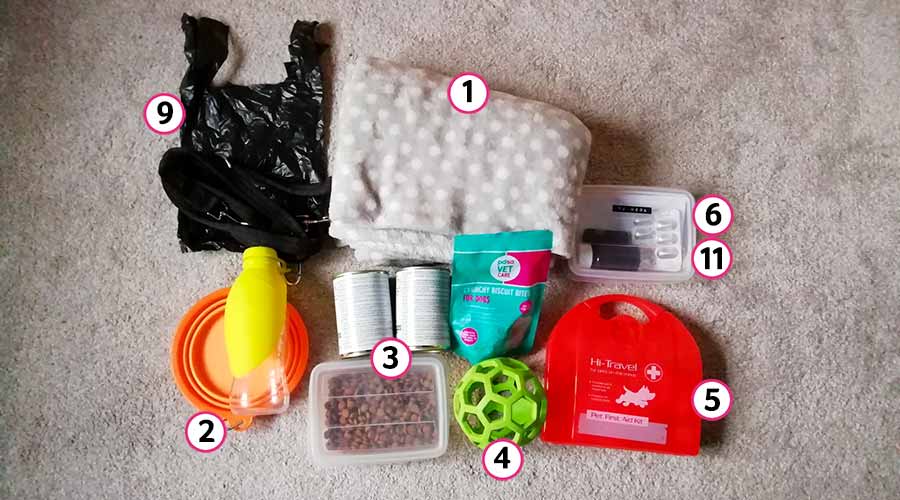Even here in the UK, things can go wrong. Nature might throw a curveball out there, or you might need to leave your home suddenly for another reason. Whatever your reasoning, it’s always good to have an emergency grab bag prepared for both your family and your pet.
Yes, it does sound a bit doomsday, but some things you just can’t predict and I’m very much of the opinion that it’s better to be prepared. With colder weather on the way, too, it can also be a good way of having emergency supplies on hand if you can’t get to the shops.
So, grab a sturdy rucksack and get packing so you and your pet are ready for anything!
Your emergency pet grab bag
Depending on the type of pet you have, you might put different things in your bag. I’ll be covering dogs and cats, but feel free to let us know what you would put in your bag for other species of pet!

1. A blanket.
Home comforts are important to us and to our pets, especially with cats and dogs who like familiarity. My dog TJ loves blankets so this is especially important, and it can also be used to keep your pet warm and comfy if there’s no pet bed for them where you go. If you have a coat for your dog, you might want to pack that, too.
2. Food and water bowls.
This might not seem like a priority, but it’s good to have a couple of small bowls in your grab bag so you have somewhere to put your pet’s food and a bowl for them to drink out of. Collapsible bowls are ideal because they won’t take up too much space.
3. Two to three days of food.
Now you could put in as much of your pet’s food as you like, but realistically it might be a bit difficult lifting a bag with a weeks’ supply of tinned food! A few days’ worth of food should be plenty to tide you over until you can get more. Make sure any food you put in is well within its expiry date and pop a note in your calendar to remind you to swap it out towards its expiry. Dry food should be kept in an airtight container if it’s not in a sealed bag – stock up on supplies in our pet store.
4. A toy or two.
Pets get bored, too! If you can, pack a toy or two for your pet to keep them occupied wherever you end up staying. It can also be a great distraction if they’re worried in an unfamiliar place.
5. A first-aid kit.
It’s a good idea to either put together your own pet first-aid kit or you can buy a ready-made one. Remember to download our free pet first-aid leaflet and keep a copy in your grab bag.
6. Important details about your pet.
You should include your own contact details, your vet’s contact details, microchip information and other important information about your pet such as any medication they are on (and when they take them) and their feeding schedule. Some people like to have a copy of their pets’ records on a memory stick just in case (but you’ll need to request this info from your vet first).
7. A brush or comb.
This sounds a bit silly, but pets with longer fur can easily become tangled and uncomfortable if they aren’t brushed regularly. TJ doesn’t need one because he has short fur, but if your pet has longer fur it’s best to pop a brush or comb in.
8. For cats: litter and tray.
It’s a good idea to get a small litter tray and either get a small bag of litter or put some of your cat’s regular litter into an airtight container. Don’t forget to take a scoop to clean it out!
9. For dogs: spare lead and poo bags.
Always put a spare lead and plenty of poo bags in your dog’s grab bag! Some owners also prefer to have a spare collar and tags in there too, just in case.
10. Water.
You can either put sealed bottles of water in your grab bag (again, be wary of dates and keep them out the sun) or, if you can, fill up empty bottles before you need to leave (although if you don’t know when you’ll need to leave this might be a bit tricky!).
11. Your pet’s medication.
It might not be possible to pre-pack your pet’s medication, but make sure you put in instructions (you can use our handy medication planner to help you). Always make sure you store your pet’s medication somewhere easily accessible if you need to grab it in a hurry (but obviously this needs to be somewhere your pet can’t get to it!).
12. A pet carrier or harness.
Again, these are a bit tricky to put in your grab bag as you’ll need them to leave the house with your pet, but they should always be somewhere easy to get to in a hurry. Remember to regularly check them over to make sure they aren’t showing signs of wear and tear, paying particular attention to locks and clasps. We keep TJ’s harness on hooks right next to the door so they’re easily accessible.

